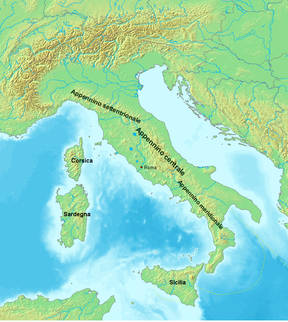Apennine Mountains
| Apennine Mountains | |
|---|---|
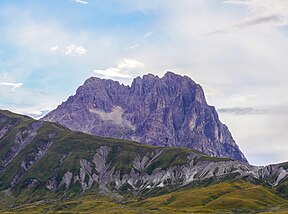 | |
| Highest point | |
| Peak | Corno Grande(Great Horn) |
| Elevation | 2,912 m (9,554 ft)[1] |
| Listing | List of mountain ranges |
| Coordinates | 42°28′9″N13°33′57″E/ 42.46917°N 13.56583°E |
| Dimensions | |
| Length | 1,200 km (750 mi) northwest to southeast |
| Width | 250 km (160 mi) southwest to northeast |
| Naming | |
| Native name | Monti Appennini(Italian) |
| Geography | |
| Countries | Italy and San Marino |
| Range coordinates | 43°16.9′N12°34.9′E/ 43.2817°N 12.5817°E |
| Geology | |
| Age of rock | Mesozoic for formation of rock, Neogene-Quaternaryfor orogeny |
| Type of rock | Apennine fold and thrust belt |
TheApennines[2]orApennine Mountains(/ˈæpənaɪn/AP-ə-nyne;Greek:Ἀπέννινα ὄρηor Ἀπέννινον ὄρος;[3]Latin:AppenninusorApenninus Mons– a singular with plural meaning;[4]Italian:Appennini[appenˈniːni])[note 1]are amountain rangeconsisting of parallel smaller chains extendingc. 1,200 km (750 mi)along the length ofpeninsularItaly.In the northwest they join with theLigurian AlpsatAltare.In the southwest they end atReggio di Calabria,the coastal city at the tip of the peninsula. Since 2000 the Environment Ministry of Italy, following the recommendations of the Apennines Park of Europe Project, has been defining the Apennines System to include the mountains of northSicily,for a total distance of1,500 kilometres (930 mi).[5]The system forms an arc enclosing the east side of theLigurianandTyrrhenianseas.
The Apennines conserve some intact ecosystems that have survived human intervention. In these are some of the best preserved forests andmontane grasslandsin Europe, now protected bynational parksand, within them, a high diversity of flora and fauna. These mountains are one of the last refuges of the big European predators such as theItalian wolfand theMarsican brown bear,now extinct in the rest ofCentral Europe.
The mountains lend their name to theApennine peninsulathat forms the major part of Italy.[6]They are mostly verdant, although one side of the highest peak,Corno Grande,is partially covered byCalderone glacier,the onlyglacierin the Apennines.[7]The eastern slopes down to theAdriatic Seaare steep, while the western slopes form foothills on which most of peninsular Italy's cities are located. The mountains tend to be named from the province or provinces in which they are located; for example, the Ligurian Apennines are inLiguria.
Etymology
[edit]The etymology most frequently repeated, because of its semantic appropriateness, is that it derives from theCelticpenn,'mountain', 'summit':[4]A-penn-inus,which could have been assigned during the Celtic domination of north Italy in the 4th century BC or before. The name originally applied to the north Apennines. However, historical linguists have never found a derivation with which they all agree.[6]Wilhelm Deecke said:"[…] its etymologyis doubtful but some derive it from the Ligurian-CeltishPenorBen,which means mountain peak. "[8]
A large number of place names seem to reflectpen:Penarrig, Penbrynn, Pencoid, Penmon, Pentir, etc. orben:Beanach, Benmore, Benabuird, Benan, Bencruachan, etc.[9]In one derivationPen/Benis cognate withOld Irishcenn,'head', but an original*kwen-would be required, which is typologically not found in languages that featurelabio-velars.WindischandBrugmannreconstructedIndo-European*kwi-,deriving also the GreekPindus Mountainsfrom the same root, but*kwen-<*kwi-is not explained by any rule.[10]By some, Englishpin,[11]as well aspenand Latinpinnaorpenna,'feather' (in the sense of the horn of the quill),[12]have been connected to the name. This view has the word originating inLatiuminconsistently with the theory of the northern origin. None of these derivations are unquestionably accepted.
History
[edit]
TheApennine cultureis atechnology complexin central and southernItalyfrom the ItalianMiddle Bronze Age(15th–14th centuries BC).[13]In the mid-20th century the Apennine was divided into Proto-, Early, Middle and Latesub- phases[13],but now archaeologists prefer to consider as "Apennine" only the ornamental pottery style of the later phase of Middle Bronze Age (BM3).
This phase is preceded by the Grotta Nuova facies (central Italy) and by the Protoapennine B facies (southern Italy) and succeeded by the Subapennine facies of 13th-century ( "Bronzo Recente" ). Apennine pottery is a burnished ware incised with spirals, meanders and geometrical zones, filled with dots or transverse dashes. It has been found onIschiaisland in association withLHIIandLHIIIpottery and onLipariin association with LHIIIA pottery, which associations date it to the Late Bronze Age as it is defined in Greece and the Aegean.[14]
The people of the Apennine culture were alpine cattle herdsmen grazing their animals over the meadows and groves of mountainous central Italy. They lived in small hamlets located in defensible places. On the move between summer pastures they built temporary camps or lived in caves and rock shelters.[14]Their range was not necessarily confined to the hills; their pottery has been found on theCapitoline Hillin Rome as well as on the islands mentioned above.
Geography
[edit]
The Apennines are divided into three sectors: northern (Appennino settentrionale), central (Appennino centrale), andsouthern (Appennino meridionale).[15]
A number of long hiking trails wind through the Apennines. Of note isEuropean walking route E1coming from northern Europe and traversing the lengths of the northern and central Apennines. TheGrand Italian Trailbegins inTriesteand after winding through the Alpine arc traverses the entire Apennine system, Sicily and Sardinia.
Northern Apennines
[edit]The northern Apennines consist of threesubchains:the Ligurian (Appennino ligure), Tuscan-Emilian (Appennino tosco-emiliano), and Umbrian Apennines (Appennino umbro).[16]
Ligurian Apennines
[edit]
The Ligurian Apennines border theLigurian Seain theGulf of Genoa,from aboutSavonabelow the upperBormidaRiver valley to aboutLa Spezia(La Cisa pass) below the upperMagraRiver valley. The range follows theGulf of Genoaseparating it from the upperPo Valley.The northwestern border follows the line of the Bormida River toAcqui Terme.There the river continues northeast toAlessandriain thePo Valley,but the mountains bend away to the southeast.
The upper Bormida can be reached by a number of roads proceeding inland at a right angle to the coast southwest ofSavona,the chief one being the Autostrada Torino-Savona. They ascend to the Bocchetta diAltare,sometimes calledColle di Cadibona,436 m (1,430 ft), the border between theLigurian Alpsalong the coast to the west and the Ligurian Apennines. A bronze plaque fixed to a stone marks the top of the pass. In the vicinity are fragments of the old road and three ruins of former fortifications.
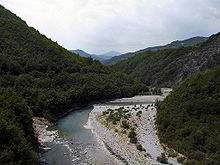
AtCarcare,the main roads connect with the upper Bormida valley (Bormida di Mallare) before turning west. TheScrivia,theTrebbiaand theTaro,tributaries of thePo River,drain the northeast slopes. The range contains dozens of peaks. Toward the southern end theAveto Natural Regional ParkincludesMonte Penna.Nearby is the highest point of Ligurian Apennines,Monte Maggiorascaat 1,800 m (5,900 ft).[16]
The main and only feasible overland route connecting the coastal plain of Liguria to the north Italian plain runs through Bocchetta di Altare. It has always been of strategic importance. Defenders of north Italy have had to control it since ancient times, as the various fortifications placed there testify.Trenitalia,the state railway system, highly developed on the coastal plain, now traverses the mountains routinely through a number of railway tunnels, such as the one atGiovi Pass.
The southeastern border of the Ligurian Apennines is the FiumeMagra,which projects into the Tyrrhenian Sea south ofLa Spezia,and the FiumeTaro,which runs in the opposite direction to join the Po. The divide between the two upper river valleys is theCisa Pass.Under it (in two tunnels) runs theAutostrada della Cisabetween Spezia andParma.
Tuscan–Emilian Apennines
[edit]

Starting atCisa Pass,the mountain chain turns further to the southeast, to cross the peninsula along the border between theEmilia-RomagnaandTuscanyregions. They are named the Tuscan–Emilian Apennines west of theFuta Passand the Tuscan–Romagnol Apennines east of it, or just the Tuscan Apennines.[16]They extend to the upperTiber River.The highest point isMonte Cimoneat 2,165 m (7,103 ft).
A separate branch, theApuan Alps,goes southwest, bordering the coast south ofLa Spezia.Whether they are to be considered part of the Apennines is a matter of opinion; certainly, they are part of the Apennine System. Topographically only the valley of the RiverSerchio,which running parallel to the coast turns and exits into the Tyrrhenian Sea north ofPisa,separates the Apuan Alps from the Apennines; geologically the rock is of a slightly different composition,marble.The Roman marble industry was centered atLuna,and is now active inCarrara.
As the Tuscan Apennines divide the peninsula between thePo Valleyand the plains and hills ofTuscanyandLazio,transportation over them has been used to achieve political and economic unity. Historically the Romans used theVia FlaminiabetweenRomeandRimini.The montane distance betweenFlorenceinTuscanyandBolognainEmilia-Romagnais shorter, but exploitation of it required the conquest of more rugged terrain, which was not feasible for the ancients. Railway lines were constructed over the mountains in the early 19th century but they were of low capacity and unimprovable.
Since 1856, a series of tunnels have been constructed to conduct "the Bologna-Florence rail line", which is neither a single line nor a single tunnel. The Porrettana Line went into service in 1864, the Direttissima in 1934 and the High Speed in 1996.[17]A few dozen tunnels support the three of them, the longest on the High-Speed Line being the Voglia Tunnel at 16.757 km (10.412 mi).[18]The longest is on the Direttissima, the Great Apennine Tunnel, which at 18.5 kilometres (11.5 miles) is the longest entirely within Italy, although theSimplon Tunnel,which connects Italy and Switzerland, is longer.[note 2]Automobile traffic is carried by the Autostrada del Sole, Route A1, which goes through numerous shorter tunnels, bypassing an old road, originally Roman, through Futa Pass. In December 2015, a new Route A1 calledVariante di Valicowas opened after many years of construction consisting of major tunnels (the longest being the new 8.6-kilometre (5.3-mile) 'Tunel Base') and new overpasses, shortening the traveling time between Florence and Bologna by road. TheForeste Casentinesi, Monte Falterona, Campigna National Parkis in the southern part of the Tuscan–Romagnol Apennines. The southern limit of the Tuscan–Romagnol Apennines is theBocca Serriola Passin northernUmbria,which linksFanoandCittà di Castello.

TheTiber RiveratRomeflows fromMonte Fumaioloin the Tuscan-Romagnol Apennine from northeast to southwest, projecting into the Tyrrhenian Sea at right angles to the shore. The upper Tiber, however, flows from northwest to southeast, gradually turning through one right angle clockwise. The northernTiber Valleyis deep and separates the Apennines on the left bank from a lesser range, the TuscanAnti-Apennines(Sub-Apennines) on its right.
Central Apennines
[edit]The Apennine System forms an irregular arc with centers of curvature located in the Tyrrhenian Sea. The northern and southern segments comprise parallel chains that can be viewed as single overall mountain ridges, such as the Ligurian Mountains. The center, being thicker and more complex, is geologically divided into an inner and an outer arc with regard to the centers of curvature. The geologic definition, however, is not the same as the geographic.
Based on rock type and orogenic incidents, the northern segment of the arc is divided into the Outer Northern Apennines (ONA) and the Inner Northern Apennines (INA).[19]The Central Apennines are divided into the Umbrian–Marchean (Appennino umbro-marchigiano) or Roman Apennines in the north and the Abruzzi Apennines (Appennino abruzzese) in the south. It extends from Bocca Serriola pass in the north to Forlì pass in the south.[16]
Umbria-Marche Apennines
[edit]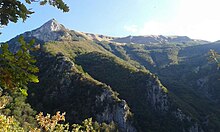
The west border of the Umbria-Marche Apennines (orAppennino umbro-marchigiano)) runs throughCagli.They extend south to theTrontoRiver, the south border of the ONA. The highest peak,Monte Vettore,at 2,478 m (8,130 ft), is part of theMonti Sibillini,incorporated intoParco Nazionale dei Monti Sibillini.Further north is theparco naturale regionale della Gola della Rossa e di Frasassi,in which are the Gola della Rossa ( "Red Gorge" ) andFrasassi Caves.Still further north is Parco Sasso Simone e Simoncello.[20]The Italian Park Service calls it the "green heart" of Italy. The region is heavilyforested,such as the Riserva Naturale Statale Gola del Furlo, whereFurlo Passon theVia Flaminiais located. Both theEtruscansand the Romans constructed tunnels here.
Abruzzi Apennines
[edit]
The Abruzzi Apennines, located inAbruzzo,Moliseand southeasternLazio,contain the highest peaks and most rugged terrain of the Apennines. They are known in history as the territory of the Italic peoples first defeated by the city ofRome.Coincidentally they exist in three parallel folds or chains surviving from theorogeny.[16]These extend in a northwest–southeast direction from theRiver Trontoto the RiverSangro,which drain into theAdriatic.The coastal hills of the east extend betweenSan Benedetto del Trontoin the north andTorino di Sangroin the south.
The eastern chain consists mainly of the southern part of theMonti Sibillini,theMonti della Laga,theGran Sasso d'ItaliaMassif and theMajellaMassif. Among them are two national parks:Gran Sasso e Monti della Laga National ParkandMajella National Park;and the Regional Park of the Monti Simbruini. Gran Sasso containsCorno Grande,the highest peak of the Apennines (2912 m).
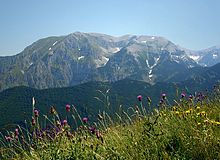
Other features between the western and central ranges are the plain ofRieti,the valley of the Salto, and theLago Fucino;while between the central and eastern ranges are the valleys ofAquilaandSulmona.The chief rivers on the west are theNera,with itstributariesthe Velino and Salto, and theAniene,both of which fall into the Tiber. On the east there is at first a succession of small rivers which flow into theAdriatic,from which the highest points of the chain are some 20km distant, such as theTronto,Tordino, Vomano and others. ThePescara,which receives theAternofrom the north-west and the Gizio from the south-east, is more important; and so is theSangro.
The central Apennines are crossed by the railway fromRometoPescaraviaAvezzanoand Sulmona: the railway fromOrtetoTerni(and thence toFoligno) follows the Nera valley; while from Terni a line ascends to the plain of Rieti, and thence crosses the central chain to Aquila, whence it follows the valley of the Aterno to Sulmona. In ancient times theVia Salaria,Via CaeciliaandVia Tiburtinaall ran fromRometo theAdriatic coast.The volcanic mountains of the province of Rome are separated from the Apennines by theTibervalley, and theMonti Lepini,part of the Volscian chain, by the valleys of theSaccoandLiri.
Southern Apennines
[edit]Samnite and Campanian Apennines
[edit]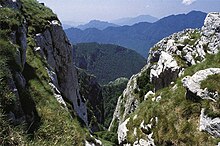
In the southern Apennines, to the south of theSangrovalley, the three parallel chains are broken up into smaller groups; among them may be named theMatese,the highest point of which is the Monte Miletto 2,050 metres (6,725 ft). The chief rivers on the south-west are theLiriorGariglianowith its tributary the Sacco, theVolturno,Sebeto, Sarno, on the north the Trigno, Biferno andFortore.[21]
Daunian mountains,inApulia,are connected with the Apennine range, and so areCilentohills on the west. On the converse the promontory ofMount Gargano,on the east, is completely isolated, and so are theCampanianvolcanic arcnearNaples.The district is traversed from north-west to south-east by the railway fromSulmonatoBeneventoand on toAvellino,and from south-west to northeast by the railways from Caianello via Isernia toCampobassoand Termoli, from Caserta to Benevento and Foggia, and fromNocera Inferioreand Avellino to Rocchetta Sant'Antonio, the junction for Foggia, Spinazzola (for Barletta, Bari, andTaranto) and Potenza. Roman roads followed the same lines as the railways: theVia Appiaran fromCapuato Benevento, whence the older road went to Venosa and Taranto and so toBrindisi,while theVia Traianaran nearly toTroia(near Foggia) and thence to Bari.[21]
Lucan Apennines
[edit]
The valley of theOfanto,which runs into the Adriatic close toBarletta,marks the northern termination of the first range of the Lucanian Apennines (nowBasilicata), which runs from east to west, while south of the valleys of the Sele (on the west) andBasento(on the east)—which form the line followed by the railway from Battipaglia viaPotenzatoMetaponto—the second range begins to run due north and south as far as the plain ofSibari.The highest point is the MontePollino2,233 metres (7,325 ft). The chief rivers are the Sele—joined by the Negro and Calore—on the west, and theBradano,Basento,Agri, Sinni on the east, which flow into the gulf of Taranto; to the south of the last-named river there are only unimportant streams flowing into the sea east and west, inasmuch as here the width of the peninsula diminishes to some 64 kilometres (40 mi).[21]
Calabrian and Sicilian Apennines
[edit]
The railway running south from Sicignano to Lagonegro, ascending the valley of the Negro, is planned to extend to Cosenza, along the line followed by the ancient Via Popilia, which beyond Cosenza reached the west coast at Terina and thence followed it to Reggio. TheVia Herculia,a branch of theVia Traiana,ran fromAequum Tuticumto the ancientNerulum.At the narrowest point the plain of Sibari, through which the rivers Coscile and Crati flow to the sea, occurs on the east coast, extending halfway across the peninsula. Here the limestone Apennines proper cease and the granite mountains ofCalabriabegin.[21]
The first group extends as far as theisthmusformed by the gulfs of South Eufemia and Squillace; it is known as the Sila, and the highest point reached is 1,930 metres (6,330 ft) (theBotte Donato). The forests which covered it in ancient times supplied the Greeks and Sicilians with timber for shipbuilding. The railway from South Eufemia toCatanzaroand Catanzaro Marina crosses the isthmus, and an ancient road may have run from Squillace to Monteleone. The second group extends to the south end of theItalian Peninsula,culminating in theAspromonte(1,960 metres (6,420 ft)) to the east ofReggio di Calabria.In both groups the rivers are quite unimportant.[21]Finally, the Calabrian southern Apennine Mountains extend along the northern coast of Sicily (the Sicilian Apennines, ItalianAppennino siculo)—Pizzo Carbonara(6,493 feet (1,979 m)) being the highest peak.
Environment
[edit]Vegetative zones
[edit]Ecoregions
[edit]
- north and central:Apennine deciduous montane forests(temperate broadleaf and mixed forestsbiome)
- north through south:Italian sclerophyllous and semi-deciduous forests(Mediterranean forests, woodlands, and scrubbiome)
- south:South Apennine mixed montane forests(also a Mediterranean biome)
The number ofvascular plantspecies in the Apennines has been estimated at 5,599. Of these, 728 (23.6%) are in the treelineecotone.Hemicryptophytespredominate in the entire Apennine chain.[22]
Alpine zone
[edit]Thetree lineecotoneis mainlygrasslandsof theMontane grasslands and shrublandsbiome; with Temperate broadleaf and mixed forests, and Mediterranean forests, woodlands, and scrub below it. The tree line in the Apennines can be found in the range 1,600 m (5,200 ft) to 2,000 m (6,600 ft).[23]About 5% of the map area covered by the Apennines is at or above the tree line—or in the treeline ecotone. Thesnow lineis at about 3,200 m (10,500 ft), leaving the Apennines below it, except for the one remaining glacier. Snow may fall from October to May. Rainfall increases with latitude.[7]The range's climates, depending on elevation and latitude, are theOceanic climateandMediterranean climate.
Fauna
[edit]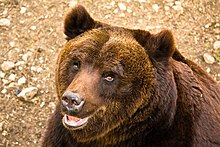



The mammal fauna[24]is mainly composed ofItalian wolves(endemic),Corsican hare,badgers,weasels,foxes,marmots,Etruscan shrew,Crested porcupine,European snow voleandApennine shrews(endemic),Marsican brown bears(endemic), theEuropean fallow deer,theEuropean mouflonand thePyrenean chamois.
There are also numerous birds[25]such as thegolden eagle,theBonelli's eagle,theEurasian goshawk,thehoopoe,thehawk,theEuropean roller,theWhite-backed woodpecker,theEuropean green woodpecker,theAlpine chough,theEgyptian vulture,theEuropean nightjar,theItalian sparrow(endemic) and theEurasian eagle-owl
There are also numerous amphibians[26]such as theApennine yellow-bellied toad(endemic), theItalian cave salamander(endemic), theItalian newt(endemic), theItalian stream frog(endemic) and theSpectacled salamander(endemic), theItalian tree frog(endemic), theAgile frog,theItalian edible frog(endemic), theCommon toad,theBalearic green toad,theNorthern spectacled salamander(endemic), theFire salamander,theSmooth newt,theAlpine newt,and theItalian crested newt.
The reptile[27]fauna is mainly composed of suc as theItalian Aesculapian snake(endemic), theDice snake,theGreen whip snake,theAesculapian snake,theSmooth snake,theVipera ursinii,theVipera aspis,theItalian wall lizard(endemic), thePodarcis muralis,theEuropean green lizard.
Notable Apennine freshwater fishes are theBrook lamprey(endemic),Lombardy lamprey,Italian bleak(endemic),Horse barbel(endemic),Eurasian carp,Scardola scardafa(endemic),European perch,Chubius Chub,TenchandNorthern pike.
TheItalian wolfis thenational animalof Italy,[28][29]while thenational birdof the country is theItalian sparrow.[30]The reasons for this choice are related to the fact that the Italian wolf, which inhabits the Apennine Mountains and theWestern Alps,features prominently in Latin and Italian cultures, such as in the legend of thefounding of Rome.[31]
Transhumance
[edit]
In Italy thetranshumancetook place mainly starting from the Abruzzi Apennines, moving both towards the Tuscan and LazioMaremmaand above all towards theTavoliere delle Puglie.[32]The Apennines are to some extent covered with forests, though these were probably more extensive in classical times (Plinymentions especiallypine,oakandbeechwoods,Hist. Nat.xvi. 177); they have indeed been greatly reduced in comparatively modern times by indiscriminate timber-felling, and though serious attempts atreforestationhave been made by the government, much remains to be done.[21]
They also furnish considerable summer pastures, especially in theAbruzzi:Pliny (Hist. Nat.xi. 240) praises the cheese of the Apennines. In the forestsItalian wolveswere frequent, and still are found, the flocks being protected against them by large sheep-dogs;Marsican brown bears,however, which were known in Roman times, have almost entirely disappeared. Nor are the wild goats calledrotae,spoken of byMarcus Terentius Varro(Rerum rusticarumII. i. 5), which may have been eitherPyrenean chamoisorsteinbock,to be found.[21]
Brigandage appears to have been prevalent in Roman times in the more remote parts of the Apennines, as it was until recently. An inscription found near the Furlo pass was set up in AD 246 by anevocatus Augusti(a member of a picked corps) on special police duty with a detachment of twenty men from the Ravenna fleet.[21]
Snow lies on the highest peaks of the Apennines for almost the whole year. The range produces no minerals, but there are a considerable number of goodmineral springs,some of which are thermal (such asBagni di Lucca,Montecatini,Monsummano,Porretta, Telese), while others are cool (such as Nocera,Sangemini,Cinciano), the water of which is both drunk on the spot and sold as table water elsewhere.[21]
National parks
[edit]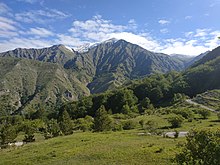
The Apennines are home to twelveItalian national parks:theAppennino Tosco-Emiliano National Park,theForeste Casentinesi, Monte Falterona, Campigna National Park,theMonti Sibillini National Park,theGran Sasso e Monti della Laga National Park,theAbruzzo, Lazio and Molise National Park,theMaiella National Park,thePollino National Park,theVesuvius National Park,theCilento, Vallo di Diano and Alburni National Park,theAppennino Lucano - Val d'Agri - Lagonegrese National Park,theSila National Park,theAspromonte National Park.
Hydrography
[edit]Important rivers originate from the Apennines are thePanaro,theSecchia,theReno,theMarecchia,theRubicon,theMetauro,theArno,theTiber,theSavio,theNera,theVelino,theTronto,theAterno-Pescara,theAniene,theLiri,theSangroand theVolturno.Among the lakes of glacial origin of the Alpine type isLago di Pilato.
Geology
[edit]
The Apennines were created in the Apennineorogenybeginning in the earlyNeogene(about 20mya,the middleMiocene) and continuing today.[33]Geographically they are partially (or appear to be) continuous with theAlpine system.Prior to the explosion of data on the topic from about the year 2000, many authors took the approach that the Apennines had the same origin as the Alps. Even today, some authors use the term Alpine-Apennine system. They are not, however, the same system and did not have the same origin. The Alps were millions of years old before the Apennines rose from the sea.
The northward movement of the African Plate and its collision with the European Plate then caused theAlpine Orogeny,beginning in the late Mesozoic. The band of mountains created extends from Spain to Turkey in a roughly east–west direction and includes the Alps. The Apennines are much younger, extend from northwest to southeast, and are not a displacement of the Alpine chain.
The key evidence of the difference is the geologic behavior of thePo Valleyin northern Italy. Compressional forces have been acting from north to south in the Alps and from south to north in the Apennines, but instead of being squeezed into mountains the valley has been subsiding at 1 to 4 mm (0.16 in) per year since about 25mya,before the Apenninesexisted.[34]It is now known to be not an erosional feature, but is a filled portion of the Adriatic Trench, called the Adriaticforedeepafter its function as a subduction zone was discovered.
Apennine orogeny
[edit]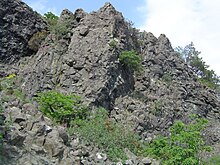
The Apennine orogeny is a type of mountain-building in which two simpler types are combined in an apparently paradoxical configuration. Sometimes this is referred to as "syn-orogenic extension", but the term implies that the two processes occur simultaneously during time. Some scientists imagine that this is relatively rare but not unique in mountain building, whereas others imagine that this is fairly common in all mountain belts.
The RETREAT Project[note 3]have this specific feature as one of their focus points[35] In essence the east side of Italy features afold and thrust beltraised by compressional forces acting under theAdriaticSea. This side has been called the "Apennine-Adriatic Compressional Zone" or the "Apennines Convergence Zone." On the west side of Italyfault-block mountainsprevail, created by a spreading or extension of the crust under theTyrrhenian Sea.This side is called the "Tyrrhenian Extensional Zone." The mountains of Italy are of paradoxical provenience, having to derive from both compression and extension:
"The paradox of how contraction and extension can occur simultaneously in convergent mountain belts remains a fundamental and largely unresolved problem in continental dynamics."
Both the folded and the fault-block systems include parallel mountain chains. In the folded systemanticlineserode into the highest and longest massifs of the Apennines.
According to the older theories (originating from the 1930s to 1970s) of Dutch geologists, including Van Bemmelen, compression and extension can and should occur simultaneously at different depths in a mountain belt. In these theories, these different levels are calledStockwerke.More recent work in geotectonics and geodynamics of the same school of geoscientists (Utrecht and Amsterdam University) by Vlaar, Wortel, and Cloetingh, and their disciples, extended these concepts even further into a temporal realm. They demonstrated that internal and external forces acting upon the mountain belt (e.g.,slab pulland intra-plate stress field modulations due to large scale reorganisations of thetectonic plates) result in both longer episodes and shorter phases of general extension and compression acting both upon and inside mountain belts and tectonic arches (See e.g. for extensive reviews, bibliography and discussions on the literature: Van Dijk (1992),[36] Van Dijk and Okkes (1991),[37] Van Dijk & Scheepers (1995),[38] and Van Dijk et al. (2000a)[39]).
Compressional zone
[edit]
The gradual subsidence of thePo Valley(including that ofVenice) and the folding of the mountains of eastern Italy have been investigated usingseismic waveanalysis of the "ApennineSubductionSystem. "[35]Along the Adriatic side of Italy the floor of theAdriatic Sea,referred to as the "Adriatic lithosphere" or the "Adriatic plate," terms whose precise meaning is the subject of ongoing research, is dipping under the slab on which the Apennines have been folded by compressional forces.
Subduction occurs along afault,along which ahanging wall,or overriding slab is thrust over an overridden slab, also called the subducting slab. In north Italy the dip of this interface is 30° to 40° at a depth of 80–90km.[40]
Thestrikeof the Apennine subduction zone forms a long, irregular arc with centers of curvature in the Tyrrhenian Sea following the hanging wall over which the mountains have been raised; i.e., the eastern wall of the mountains. It runs from near the base of the Ligurian Apennines in the Po Valley along the margin of the mountains to the Adriatic, along the coastal deeps of the Adriatic shore, strikes inland atMonte Garganocutting offApulia,out to sea again through theGulf of Taranto,widely around the rest of Italy andSicilyand across inland north Africa.[40]Theupper mantleabove 250 km (160 mi) deep is broken into the "Northern Apennines Arc" and the "Calabrian Arc", with compressional forces acting in different directions radially toward the arcs' centers of curvature.
Extensional zone
[edit]
The west side of Italy is given to afault-blocksystem, where the crust – extended by the lengthening mantle below – thinned, broke along roughly parallelfaultlines, and the blocks alternatively sank intograbensor were raised byisostasyintohorsts.This system prevails fromCorsicaeastward to the valley of theTiber River,the last rift valley in that direction. It runs approximately across the direction of extension. In the fault-block system, the ridges are lower and are more steep-sided, since the walls are formed by faults. Geographically they are not considered part of the Apennines proper but are termedSub-Apennines(Subappennini) orAnti-Apennines(Antiappennini) orPre-Apennines(Preappennini). These mountains are found mainly inTuscany,LazioandCampania.
Stability of terrain
[edit]
The terrain of the Apennines (as well as that of the Alps) is to a large degree unstable due to various types oflandslides,including falls and slides of rocks and debris, flows of earth and mud, and sink holes. The Institute for Environmental Protection and Research (Istituto Superiore per la Protezione e la Ricerca Ambientale), a government agency founded in 2008 by combining three older agencies, published in that year a special report,Landslides in Italy,summarizing the results of the IFFI Project (Il Progetto IFFI), the Italian Landslide Inventory (Inventario dei Fenomeni Franosi in Italia), an extensive survey of historical landslides in Italy undertaken by the government starting in 1997. On December 31, 2007, it had studied and mapped 482,272 landslides over 20,500 km2(7,900 sq mi). Its major statistics are the Landslide Index (LI here), the ratio of the landslide area to the total area of a region, the Landslide Index in Mountainous-Hilly Areas (here LIMH) and the Density of Landslides, which is the number per 100 km2(39 sq mi).
Italy as a whole has a LI of 6.8, a LIMH of 9.1 and a density of 160.Lombardia(LI of 13.9),Emilia-Romagna(11.4),Marches(19.4),Molise(14.0),Valle d'Aosta(16.0) andPiemonte(9.1) are significantly higher.[41]The most unstable terrain in the Apennines when the landslide sites are plotted on the map are in order from most unstable the eastern flanks of the Tuscan-Emilian Apennines, the Central Apennines and the eastern flank of the southern Apennines. Instability there is comparable to the Alps bordering thePo Valley.The most stable terrain is on the western side:Liguria,Tuscany,UmbriaandLazio.The Apennines are slumping away to the northeast into the Po Valley and the Adriaticforedeep;that is, the zone where the Adriatic floor is being subducted under Italy. Slides with large translational or rotational surface movements are most common; e.g., a whole slope slumps into its valley, placing the population there at risk.
Glacial ice
[edit]Glaciers no longer exist in the Apennines outside theGran Sasso d'Italiamassif. However, post-Pliocenemoraineshave been observed in Basilicata.
Major peaks
[edit]The Apennines include about 21 peaks over 1,900 m (6,200 ft), the approximatetree line(counting only the top peak in each massif). Most of these peaks are located in the Central Apennines.[23]
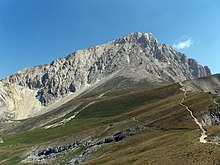



| Name | Height |
|---|---|
| Corno Grande (Gran Sasso massif) |
2,912 m (9,554 ft) |
| Monte Amaro (Majella massif) |
2,793 m (9,163 ft) |
| Monte Velino | 2,486 m (8,156 ft) |
| Monte Vettore | 2,476 m (8,123 ft) |
| Pizzo di Sevo | 2,419 m (7,936 ft) |
| Serra Dolcedorme (Pollino massif) |
2,267 m (7,438 ft) |
| Monte Meta | 2,241 m (7,352 ft) |
| Monte Terminillo | 2,217 m (7,274 ft) |
| Monte Sibilla | 2,173 m (7,129 ft) |
| Monte Cimone | 2,165 m (7,103 ft) |
| Monte Viglio | 2,156 m (7,073 ft) |
| Monte Cusna | 2,121 m (6,959 ft) |
| Montagne del Morrone | 2,061 m (6,762 ft) |
| Monte Prado | 2,053 m (6,736 ft) |
| Monte Miletto (Matese massif) |
2,050 m (6,730 ft) |
| Alpe di Succiso | 2,017 m (6,617 ft) |
| Monte Cotento (Simbruini range) |
2,015 m (6,611 ft) |
| MonteSirino | 2,005 m (6,578 ft) |
| Montalto (Aspromonte massif) |
1,955 m (6,414 ft) |
| Monte Pisanino | 1,946 m (6,385 ft) |
| Monte Botte Donato (Sila plateau) |
1,928 m (6,325 ft) |
| Corno alle Scale | 1,915 m (6,283 ft) |
| Monte Alto | 1,904 m (6,247 ft) |
| Monte Alpi | 1,900 m (6,200 ft) |
| MonteCervati | 1,898 m (6,227 ft) |
| La Nuda | 1,894 m (6,214 ft) |
| Monte Maggio | 1,853 m (6,079 ft) |
| Monte Maggiorasca | 1,799 m (5,902 ft) |
| Monte Giovarello | 1,760 m (5,770 ft) |
| Monte Catria | 1,701 m (5,581 ft) |
| Monte Gottero | 1,640 m (5,380 ft) |
| Monte Pennino | 1,560 m (5,120 ft) |
| Monte Nerone | 1,525 m (5,003 ft) |
| Monte San Vicino | 1,480m (4,856ft) |
| Monte Fumaiolo | 1,407 m (4,616 ft) |
See also
[edit]- Geography of Italy
- List of national parks of Italy
- List of longest tunnels
- List of highest paved roads in Europe
- List of mountain passes
- Lunar Apennine mountains
Notes
[edit]- ^LatinApenninus(GreekἈπέννινοςorἈπέννινα) has the form of an adjective, which would be segmentedApenn-inus,often used with nouns such asmons( "mountain" ) or Greekὄρος(óros), butApenninusis just as often used alone as a noun. The ancient Greeks and Romans typically but not always used "mountain" in the singular to mean one or a range; thus, "the Apennine mountain" refers to the entire chain and is translated "the Apennine mountains". The ending can vary also by gender depending on the noun modified. The Italian singular refers to one of the constituent chains rather than to a single mountain, and the Italian plural refers to multiple chains rather than to multiple mountains.
- ^Claims of being the longest or second-longest in the world have been soon outdated. SeeList of longest tunnels.
- ^The Retreating-trench, extension and accretion (RETREAT) Project is a study conducted by a consortium of scientific organizations in different countries including in the US theNational Science Foundation.
References
[edit]- ^"Topographic map of Corno Grande".opentopomap.org.Retrieved2023-06-11.
- ^EntryApennines,inMerriam-Webster Dictionary,on-line onwww.merriam-webster.com.
- ^Strabo,Geography,book 5.
- ^abc Lewis, Charlton T.; Short, Charles (1879)."Apenninus".A Latin Dictionary.Oxford; Medford: Clarendon Press; Perseus Digital Library.
- ^ab Gambino, Roberto; Romano, Bernardino (2000–2001).Territorial strategies and environmental continuity in mountain systems: The case of the Apennines (Italy)(PDF).World Commission on Protected Areas.
- ^abLake 1911,p. 161.
- ^abPedrotti & Gafta 2003,p. 75
- ^Deecke 1904,p. 23
- ^Blackie & Blackie 1887,pp. 21, 154
- ^"ceann".MacBain's Dictionary.
- ^"pin".Webster's Third New International Dictionary.
- ^"*pet-".The American Heritage Dictionary of the English Language, Indo-European Roots.
- ^abColes, John M.; Harding, A. F. (1979).The bronze age in Europe: an introduction to the prehistory of Europe, c. 2000–700 BC(illustrated ed.). London: Taylor & Francis. p. 165.ISBN978-0-416-70650-5.
- ^abBury, J. B.; I E S Edwards; C. J. Gadd; John Boardman; N. G. L. Hammond (1975). P. Mack Crew (ed.).The Cambridge Ancient History: c. 1800–1380 B.C.Vol. II, part 2: c. 1380–1000 B.C. (3, revised ed.). Cambridge University Press. p. 720.ISBN978-0-521-08691-2.
- ^Martini & Vai 2001,p. 3.
- ^abcdeMerriam-Webster 2001,p. 59.
- ^Lunardi 2008,pp. 413–414.
- ^Lunardi 2008,pp. 425–437.
- ^Barchi et al. 2001,p. 216.
- ^"Parks, Reserves and other Protected Areas in the Marches".Parks.it. 1995–2010.Retrieved15 March2010.
- ^abcdefghiLake 1911,p. 162.
- ^Pedrotti & Gafta 2003,p. 79.
- ^abPedrotti & Gafta 2003,p. 73.
- ^"Mammiferi d'Italia - Ministero della Transizione Ecologica"(PDF)(in Italian). p. 7.Retrieved11 March2022.
- ^"Appennini - Uccelli"(in Italian).Retrieved11 March2022.
- ^"Quali sono gli anfibi autoctoni?"(in Italian).Retrieved11 March2022.
- ^Peter Uetz; Jakob Hallermann; Jiri Hosek."Distribution: italy".The Reptile Database.Retrieved22 June2021.
- ^Sheri Foster (January 2021)."What is Italy national animal?".Yourtrip.com.
- ^James Hansen (June 2018)."Il lupo grigio degli appennini e l animale dell Italia".
- ^"Italian House Sparrow".EBN Italia. 1 May 2015.Retrieved10 May2015.
- ^Livy (1797).The history of Rome.George Baker (trans.). Printed for A. Strahan.
- ^"Tratturi"(in Italian).Retrieved13 October2023.
- ^ab
James, Kristen (2004),Determining the source for the magmas of Monte Amiata (Central Italy) using strontium, neodymium, and lead isotopes,Carleton Geology Department: Geology Comps Papers, pp. 3–4,S2CID43061617,
During theNeogeneand into theQuaternarythe region aroundAmiataunderwent a general NNE contraction.... This compression also created the Apennine orogeny of east-central Italy.... This area was broughtabove sea levelduring a doming phase during the MiddlePliocene.
- ^Ollier, Cliff; Pain, Colin (2000).The origin of mountains.London: Routledge. p. 77.
Apennine thrusts move in from the south, and Southern Alps thrust in from the north, but instead of collisional compression there is subsidence and horizontal sedimentation.
- ^abMargheriti 2006,p. 1120.
- ^van Dijk, J.P. (1992). "Late Neogene fore-arc basin evolution in the Calabrian Arc (Central Mediterranean). Tectonic sequence stratigraphy and dynamic geohistory. With special reference to the geology of Central Calabria".Geologica Ultraiectina.92:288.
- ^van Dijk, J.P.; Okkes, F.W.M. (1991). "Neogene tectonostratigraphy and kinematics of Calabrian Basins. implications for the geodynamics of the Central Mediterranean".Tectonophysics.196(1–2): 23–60.Bibcode:1991Tectp.196...23V.doi:10.1016/0040-1951(91)90288-4.
- ^van Dijk, J.P.; Scheepers, P.J.J. (1995). "Neogene rotations in the Calabrian Arc. Implications for a Pliocene-Recent geodynamic scenario for the Central Mediterranean".Earth-Science Reviews.39(3–4): 207–246.Bibcode:1995ESRv...39..207V.doi:10.1016/0012-8252(95)00009-7.hdl:1874/19084.S2CID128811666.
- ^ab van Dijk, J.P.; Bello, M.; Brancaleoni, G.P.; Cantarella, G.; Costa, V.; Frixa, A.; Golfetto, F.; Merlini, S.; Riva, M.; Toricelli, S.; Toscano, C.; Zerilli, A. (2000). "A new structural model for the northern sector of the Calabrian Arc".Tectonophysics.324(4): 267–320.Bibcode:2000Tectp.324..267V.doi:10.1016/S0040-1951(00)00139-6.S2CID130289171.
- ^abMargheriti 2006,p. 1124.
- ^Trigila, Alessandro; Iadanza, Carla (2008)."Landslides in Italy: Special Report 2008"(PDF).Rome: Istituto Superiore per la Protezione e la Ricerca Ambientale (ISPRA). pp. 15–16. Archived fromthe original(PDF)on 2011-07-17.
Bibliography
[edit]- "Apennines".Merriam-Webster's Geographical Dictionary(3rd ed.). Merriam-Webster, Incorporated. 2001.
- Blackie, Christina; Blackie, John Stuart (1887).Geographical etymology, a dictionary of place-names giving their derivations.London: Murray.
- Deecke, W (1904).Italy; a popular account of the country, its people, and its institutions (including Malta and Sardinia).Translated by Nesbitt, H A. London; New York: Macmillan Co.; S. Sonnenschein & Co.
- Lunardi, Pietro (2008).Design and construction of tunnels: analysis of controlled deformation in rocks and soils (ADECO-RS).Berlin: Springer.
- Margheriti, Lucia; et al. (August–October 2006)."The subduction structure of the Northern Apennines: results for the RETREAT seismic deployment"(PDF).Annals of Geophysics.49(4/5). Archived fromthe original(PDF)on 2010-06-19.
- Martini, I. Peter; Vai, Gian Battista (2001). "Geomorphologic Setting". In Martini, I. Peter; Vai, Gian Battista (eds.).Anatomy of an orogen: the Apennines and adjacent Mediterranean basins.Dordrecht [u.a.]: Kluwer Academic Publishers. pp. 1–4..
- Barchi, Massimiliano; Landuzzi, Alberto; Minelli, Giorgio; Pialli, Giampaolo (2001). "Inner Northern Apennines". In Martini, I. Peter; Vai, Gian Battista (eds.).Anatomy of an orogen: the Apennines and adjacent Mediterranean basins.Dordrecht [u.a.]: Kluwer Academic Publishers. pp. 215–254..
- Pedrotti, F.; Gafta, D. (2003). "The High Mountain Flora and Vegetation of the Apennines and the Italian Alps". In Nagy, László; Grabherr, G.; Körner, Ch.; Thompson, D.B.A. (eds.).Alpine biodiversity in Europe.Ecological studies, 167. Berlin, Heidelberg [u.a.]: Springer-Verlag. pp. 73–84..
- Attribution
- This article incorporates text from a publication now in thepublic domain:Lake, Philip (1911). "Apennines".InChisholm, Hugh(ed.).Encyclopædia Britannica.Vol. 2 (11th ed.). Cambridge University Press. pp. 161–163.
External links
[edit]- "Ligurian Apennine".Summit Post. 2006.Retrieved16 February2010.
- "Italian Cultural Landscapes: wood-pasture and wood-meadow in the Ligurian-Tuscan-Aemilian Apennines, Italy".The ECL project. Archived fromthe originalon 17 September 2007.Retrieved16 February2010.
- "Appenine [sic] deciduous montane forests ".Terrestrial Ecoregions.World Wildlife Fund.Retrieved16 February2010.
- Irlam, Michael J. (2009)."The Great Apennine Tunnel".Mike's Railway History.Retrieved16 February2010.
- "10th Mountain Division – The Formative World War II Years".Dartmouth College Class of 1965. 2008.Retrieved16 February2010.

